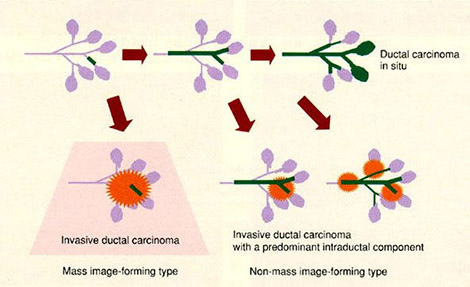Knowledge Base
-
What is Breast Cancer?
Breast cancer is the over growth of abnormal cells in the breast also known as a malignant tumor. Breast cancer has the potential to affect everyone considering the fact that only 5-10% of all cancer incidences are linked to family inheritance.
It is the most common form of cancer diagnosed in women. Breast cancer is the leading cause of cancer death among young African American women. Research shows that 13% of all women will develop breast cancer in her lifetime.
In 2004, it was estimated that 32% of all U.S. cancer cases were of breast cancer. That is almost 1 out of 3 women! In California alone, over 20,000 women are diagnosed with breast cancer annually. There are some parts in the bay area to be considered the breast cancer capital of the world
-
What are the different types of Breast Cancer?
Breast cancers can start in any tissue of the breast. However, most breast cancers start in the ducts, a smaller percentage start in the lobules, and even fewer start in other tissues of the breast. The different types of breast cancer are named for various features of the particular disease. Some types of breast cancer are named based on where the disease began, such as invasive ductal carcinoma. Other types of cancer are named based on their appearance under a microscope. For example, tubular carcinoma appears as tube-shaped cells under the microscope. Each of the different types of breast cancer has distinct prognosis and symptoms.
The most common types of Breast Cancer are:
• Ductal Carcinoma (85 - 90% of all cases) Invasive (or infiltrating) ductal carcinoma. Accounting for 70 percent of all breast cancers, this is the most common type of breast cancer. It begins inside the duct and then penetrates the duct's wall to reach the fatty tissue of the breast. From there, it has the potential to spread (or metastasize) to other parts of the body through the lymphatic system and bloodstream.
• Lobular Carcinoma (8% of all cases) Invasive (or infiltrating) lobular carcinoma. This is the second-most common tumor type, accounting for ten percent of all breast cancer. It begins in the terminal ducts of the breast milk-producing glands.
• Medullary carcinoma (3 to 6%) Although only three to six percent of all breast cancers are medullary carcinomas, this type of cancer is much more common in women with a genetic predisposition to breast cancer. In fact, different studies have found that between 13 and 19 percent of all cancers in women who carry a BRCA1 mutation are medullary carcinomas. In this type of cancer, the border between the cancer tissue and the normal tissues is relatively well-defined. Generally, the prognosis for patients with medullary carcinoma is better than for women with other types of invasive ductal or lobular carcinoma.

Less common types of Breast Cancer are:
• Inflammatory breast cancer (occurs in the skin) This cancer accounts for only approximately one percent of all breast cancers. It is named after its characteristic initial symptoms, which include redness, warmth, and swelling of the skin of the breast — often without a distinctive lump. These symptoms, which have the appearance of an infection or inflammation, are caused by cancer cells blocking lymph vessels or channels in the skin over the breast.
• Paget's disease of the nipple This unique type of breast cancer only accounts for three percent of all breast cancer. It involves the nipple and areola, and is often associated with abnormal scaling and redness of the skin of the nipple and areola. Women may also have burning or itching. Paget's disease may be associated with in situ or invasive cancer. If there is no lump or evidence of ductal carcinoma in situ by biopsy, the prognosis is very good.
-
What is Mammography?
Presented and reviewed by committees from the American College of Radiology (ACR) and the Radiological Society of North America (RSNA).
-
What are the symptoms of Breast Cancer?
• a lump or a thickening in the breast or in the armpit
• a change of size or shape of the mature breast
• fluid (not milk) leaking from the nipple
• a change of size or shape of the nipple
• a change of color or texture of the nipple or the areola
• a change of the skin of the breast itself (dimples, puckers, rash)You can find out more about the symptoms of breast cancer here.
-
Breast Cancer 101
Dennis R. Holmes, M.D. Breast Cancer Specialist and Surgeon.